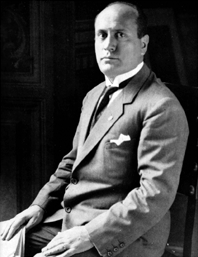Mussolini and the Roman Catholic Church
As the Roman Catholic Church held such sway in Italy, it was vital that Mussolini foster a strong link with the institution, regardless of his beliefs of that of his dictatorship. While he may have overseen Italy’s political side, the church oversaw the spiritual side.
Whatever Mussolini’s beliefs may have been, he had to keep the Roman Catholic Church on side once he came to power and ensure a strong link with this powerful institution.
Mussolini’s father had not been in favour of the Church and of the sheer power it held and, as a child, Mussolini agreed with this viewpoint. However, once he came to power, he had to take note of the sheer amount of power the Church levied and could not afford to anger it. Mussolini saw that the Pope stood for “400 million men scattered the world over…(this was) a colossal force.”
Mussolini opted to work with, rather than against, the Church, therefore ensuring that the Italian general public did not have to choose between his leadership and their religious beliefs. He set about encouraging the Roman Catholic Church to accept a Fascist state, while promising to fulfill the Church’s requests.

As part of this move, and to boost his own credibility - and that of his Party - among religious leaders, he arranged a religious wedding ceremony with his wife, Rachele, in 1926, three years after the pair had their children baptised in 1923. He also made public swearing a crime and shut the doors of many shops selling alcohol. He made public his disapproval of contraception, something that the Roman Catholic Church felt strongly about, and pushed for the institution of divorce to be banned across Italy.
However, despite all these efforts, the relationship between the Church and Mussolini was not always smooth. One of the major issues that the two disagreed strongly over was that of education. Both the Church and Mussolini wished to have the power to control education in the country and the efforts to resolve this disagreement took three years to come to fruition and serve their purpose. In 1929, agreements called the Lateran Treaties were signed, which set out who would control education in Italy, as well as a host of other agreements.
While the Roman Catholic Church had lost much of its land when Italy was unified in 1870, it was compensated to the tune of £30 million in 1929 and given land in Rome in which to construct the Vatican, the new papal state. On top of this, the Pope was given a small army, rail station and police force.
The Lateran Treaties also specified that the Roman Catholic faith was to be the state religion, in a section called the Concordat. This set out rules around religion in Italy, in that children in both primary and secondary schools had to have religious education at school. The Church was also given control over marriage and the appointing of bishops, though the latter still had to be agreed by the Government before the appointment could be finalised. Mussolini’s efforts to retain a relationship with the Church seemed to have paid off during these years, and his popularity with members of the Italian general public - who did not have to split their loyalties between the Church and the Government - grew.
The two were to still have disagreements though – one of the key ones being the Charter of Race, which was rolled out in July 1938 and removed the Italian Jews right of Italian nationality. These Jews had a number of restrictions placed upon them, including not being permitted to take state jobs, teach or be members of the Fascist Party. They could also not marry non-Jewish Italians. Such was the unpopularity of these rules that Mussolini received a protest from the Pope on behalf of the Italian Jews.
See also: Mussolini's Dictatorship
MLA Citation/Reference
"Mussolini and the Roman Catholic Church". HistoryLearning.com. 2025. Web.
